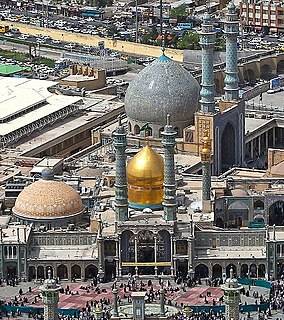
The Golestan Palace is the former royal Qajar complex in Iran's capital city, Tehran.

The Qajar dynasty was an Iranian royal dynasty of Turkic origin, specifically from the Qajar tribe, ruling over Iran from 1789 to 1925. The Qajar family took full control of Iran in 1794, deposing Lotf 'Ali Khan, the last Shah of the Zand dynasty, and re-asserted Iranian sovereignty over large parts of the Caucasus. In 1796, Mohammad Khan Qajar seized Mashhad with ease, putting an end to the Afsharid dynasty, and Mohammad Khan was formally crowned as Shah after his punitive campaign against Iran's Georgian subjects. In the Caucasus, the Qajar dynasty permanently lost many of Iran's integral areas to the Russians over the course of the 19th century, comprising modern-day Georgia, Dagestan, Azerbaijan and Armenia.

Ahmad Shah Qajar was Shah (King) of Persia from 16 July 1909 to 15 December 1925, and the last ruling member of the Qajar dynasty.

Mohammad Shah Qajar was the Qajar king of Iran.

Mozaffar ad-Din Shah Qajar was the fifth Qajar king of Persia (Iran), reigning from 1896 until his death in 1907. He is often credited with the creation of the Persian constitution, which he approved of as one of his final actions as Shah.

Naser al-Din Shah Qajar, also Nassereddin Shah Qajar, was the Shah of Persia from 5 September 1848 to 1 May 1896 when he was assassinated. He was the son of Mohammad Shah Qajar and Malek Jahān Khānom and the third longest reigning monarch in Iranian history after Shapur II of the Sassanid dynasty and Tahmasp I of the Safavid Dynasty. Nasser al-Din Shah had sovereign power for close to 50 years and was also the first modern Iranian monarch to formally visit Europe.

Dar ul-Funun, established in 1851, was the first modern university and modern institution of higher learning in Iran (Persia).

Prince Iraj Mirza, son of prince Gholam-Hossein Mirza, was a famous Iranian poet. He was a modern poet and his works are associated with the criticism of traditions. He also made translation of literary works from French into Persian.

Abol Hasan Sabā was a renowned Iranian composer, violinist, and setar player.

Mirza Hasan Ashtiani, commonly known by the bestowed title Mostowfi ol-Mamalek was an Iranian politician who served as Prime Minister on six occasions from 1910 to 1927.

The Shrine of Fatima Masumeh is located in Qom, which is considered by Shia Muslims to be the second most sacred city in Iran after Mashhad.

Khanlar Mirza whose royal title was Ehtesham-ed-Dowleh was one of the most prominent princes of the Qajar dynasty. He was the seventeenth son of Crown Prince Abbas Mirza and commander of Nasser al-Din Shah's forces in Bushehr during the Anglo-Persian War.
Ed-Dowleh is a suffix used as part of titles for members of royalty who were in governing positions during the Qajar dynasty in Iran (Persia). Some of the children of Abbas Mirza who were governors also carried this title. It derives from the medieval Arabic title al-Dawla. The suffix translates literally into "of the government" but in actual usage is meant to refer to the shah who bestows the title of -dowleh. Ed-Dowleh can also be translated as "of the Empire or State."

Iranian Princess Ashraf, titled Fakhr-ol-Dowleh (1883–1955), meaning pride of the state, was one of the most prominent daughters of Mozaffar al-Din Shah Qajar of the Qajar dynasty, who had a reputably strong character, to the point that she was even willing and able to confront Reza Shah for her patrimony and right.
Prince Ahmad Mirza Azd es-Saltaneh (1891-1939), was the last son of Nasser al-Din Shah and princess Turan es-Saltaneh and full brother of Zahra Khanom Tadj es-Saltaneh. He studied Military at Theresianum in Austria, with his brother Yamin ed-Dowleh. During Azd es-Saltaneh and Yamin ed-Dowleh stay in Austria, Franz Joseph I generously received the brothers of Shah and several times invited them to his palace. In 1913, when Mohammad Hassan Mirza lived in Tabriz, Prince Azd es-Saltaneh was the Military commander of Azerbaijan. Ahmad Mirza didn't have any children. He died in 1939 and buried in Qom.

Kamran Mirza, was the Persian Prince of Qajar Dynasty and third surviving son of Nasser al-Din Shah. He was brother of Mass'oud Mirza Zell-e Soltan and Mozzafar al-Din Shah. He is also the progenitor of Kamrani Family. He might have been Prime minister of Iran for a few days in April–May 1909, but this is not clearly referenced. Kamran Mirza also served as Iran's Commander-in-Chief, appointed in 1868 for the first time, and minister of war from 1880 to 1896 and from 1906 to 1907.
Prince Nosrat al-Din Mirza Salar es-Saltaneh was a Qajar prince and painter, son of Nasser-al-Din Shah and princess Zinat es-Saltaneh grand-Daughter of Abbas Mirza.

Hajji Mohammad Hossein Isfahani was an architect and political leader in Isfahan, Persia under the rule of Qajar Persian emperor Fath Ali Shah.

Abu'l-Hasan Khan Ghaffari Kashani (1814–1866), also known as Sani ol Molk was an Iranian painter, miniature and lacquer artist and book illustrator.

Prince Anoushiravan Mirza "Zia' od-Dowleh" "Amir Touman" was a Persian prince of the Qajar dynasty that ruled Iran 1785-1925. He became a well known politician at the imperial court at Tehran and popular governor of the Iranian province of Semnan in the late 19th century.

















